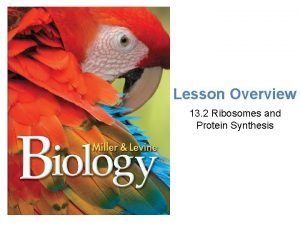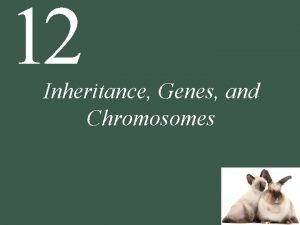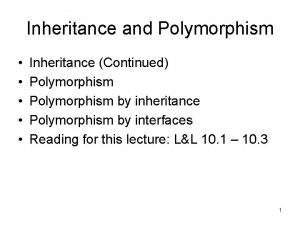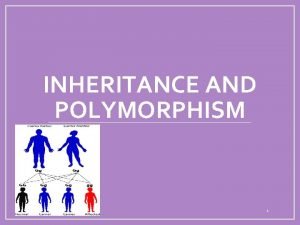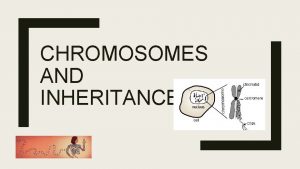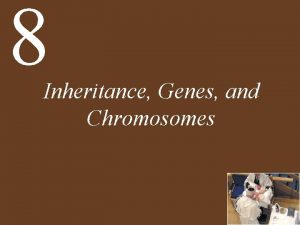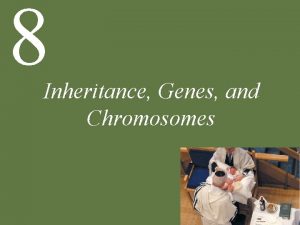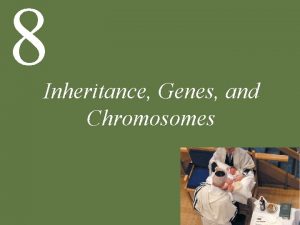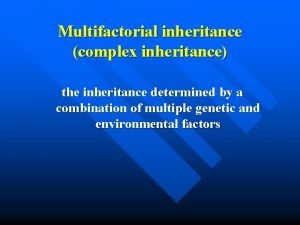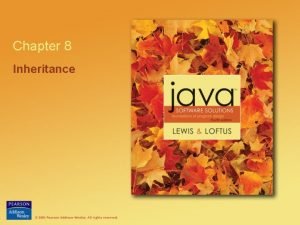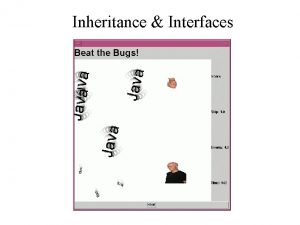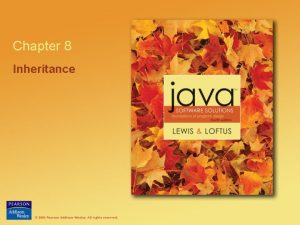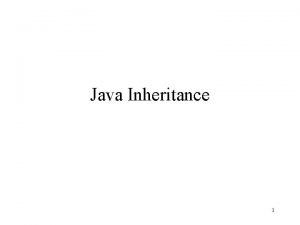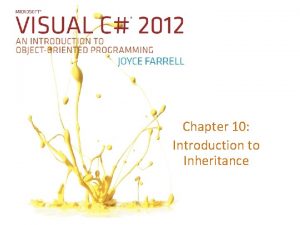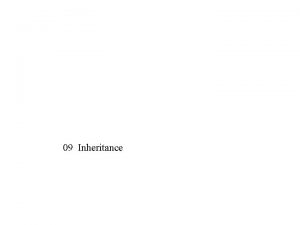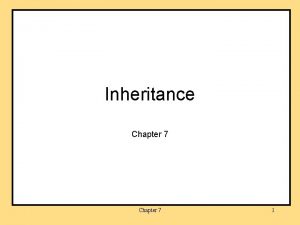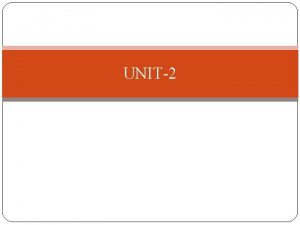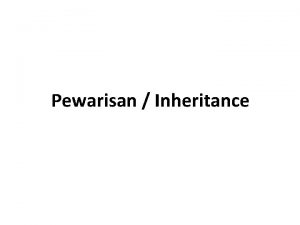Genes and Inheritance Genes contain the information for























































- Slides: 55

Genes and Inheritance ‣ Genes contain the information for the production of proteins and functional RNA molecules. ‣ Proteins are responsible for the physical expression of genes as phenotypic characteristics or traits, such as eye color. Chromosome Gene Protein ‣ Since genes are inherited, traits are also inherited. Trait

Inheritance of Traits ‣ Sexual reproduction In organisms that reproduce sexually, traits are inherited through gametes. Gametes (sperm and eggs, or pollen and ova) are produced by meiosis. Offspring possess a combination of genes from both parents. ‣ Asexual reproduction Barring mutation, the offspring of organisms that reproduce asexually (i. e. without meiosis) are genetically identical clones of the parent. In sexual reproduction, haploid sperm and egg unite to form a diploid zygote. In some exceptions, genetic material can be exchanged between clones. Example: antibiotic resistance in bacteria can be transferred via plasmid DNA Bacteria reproduce asexually by binary fission.

Binary Fission and Budding ‣ Organisms such as bacteria and some single celled protists reproduce asexually by binary fission. Binary fission involves the single parent cell dividing into two daughter cells. ‣ Asexual reproduction in some Binary fission in the bacterium Staphylococcus multicellular organisms (e. g. coelenterates such as Hydra and some plants) occurs by budding. In budding, part of the parent body is ‘pinched off’ to produce a small individual exactly like the parent. Budding in Hydra New individual

Sexual Reproduction 1 ‣ Most plants and animals reproduce through sexual reproduction, at least some of the time. ‣ This involves genetic input from two parents. The random sorting of parental genes provides new combinations in each offspring. Except for identical twins the offspring are all unique. The diversity in the genetic make-up of offspring means that some may be better able to survive and reproduce in the prevailing environment. Family resemblances can be traced through generations but, with the exception of identical twins, each individual is unique.

Asexual Reproduction ‣ In asexual reproduction, there is no exchange of genetic material between clonal lines; strains developing mutations will compete. Generation 1 2 3 4 5 Original population Mutant strain B Mutant strain A

Sexual Reproduction 2 ‣ In sexually reproducing organisms, favorable mutations can combine in a single individual and may confer a competitive advantage. Original population Mutant strain B Strains combine Mutant strain A

Sexual vs Asexual Reproduction Sexual Reproduction Asexual Reproduction Sexual reproduction has adaptive advantages because the offspring are genetically variable. Asexual reproduction allows populations of well adapted clones to increase quickly in favorable environments. Some individuals may be better suited to the prevailing environment than others and will produce more offspring. These clones may be more vulnerable than others when the environment changes. Daphnia with eggs. These diploid eggs are produced mitotically and hatch into clones of the adult. As they cannot produce variable offspring, they may be outcompeted by other better suited clonal lines. Some organisms, e. g. aphids and water fleas (Daphnia), reproduce asexually most of the time, but compensate for a lack of genetic variability by introducing short periods of sexual reproduction as well.

Location of Genes ‣ The position of a gene on a Chromosome from egg (maternal origin) Chromosome from sperm (paternal origin) chromosome is the locus. ‣ In sexually reproducing organisms, most cells have a homologous pair of chromosomes (one from each parent). Locus for gene A Two genes for different traits at different loci on the same chromosome ‣ Chromosomes from a homologous pair have genes that control the same trait at the same locus. Locus for gene B Homologous pair of chromosomes

Homologous Chromosomes ‣ This diagram illustrates the complete chromosome complement for a hypothetical organism. ‣ It has a total of ten chromosomes, comprising five nearly identical pairs (each pair is numbered). Maternal chromosome that originated from the egg of this individual's mother Paternal chromosome that originated from the sperm of this individual's father

‣ Genes occupying the same position (locus) on homologous chromosomes are alleles (versions). Any one individual can only have a maximum of two alleles for a given gene. There may be more than two alleles in a population, e. g blood groups A, B, O. These two different versions of gene A create a condition known as heterozygous. Only the dominant allele (A) will be expressed. When both chromosomes have identical copies of the recessive allele for a gene, the organism is said to be homozygous recessive for that gene. Maternal chromosome that originated from the egg of this person's mother. When both chromosomes have identical copies of the dominant allele for a gene, the organism is said to be homozygous dominant for that gene. Genes occupying the same locus or position on a chromosome code for the same trait and are alleles. Paternal chromosome that originated from the sperm of this person's father.

Gregor Mendel ‣ Gregor Mendel (1822 -1884) was an Austrian monk who is regarded as the father of genetics. Mendel carried out pioneering work using pea plants to study the inheritance patterns of a number of traits (characteristics). Mendel observed that characters could be masked in one generation of peas but could reappear in later generations. What we now call Mendelian genetics is the study of inherited characteristics.

Mendel’s View of Inheritance Parent A Parent B Mendel observed that characters could be masked in one generation of peas but could reappear in later generations. Parent A Parent B Offspring He showed that inheritance was particulate in its nature (not blending as was previously thought). Old Idea Blending of parental traits Offspring We now know these units of inheritance are genes. New Idea Inherited traits behave as discrete units

Mendel’s Pea Experiments Mendel examined a small number of phenotypic characters or traits in peas. With one exception, each character he studied is determined by one gene, for which there are two alleles, one dominant and one recessive. He found that these traits were inherited in predictable ratios depending on the phenotype of the parents. Mendel’s results from crossing heterozygous plants produced remarkably consistent phenotypic ratios. Seed color yellow dominant over green Pod color green dominant over yellow Images courtesy of Newbyte. com Pod shape inflated dominant over constricted Seed shape round dominant over wrinkled

Mendel’s Pea Experiments Stem length tall dominant over dwarf Images courtesy of Newbyte. com

Mendel’s Pea Experiments Axial Terminal Flower position axial dominant over terminal (geneticists since have found that flower position is actually determined by two genes) Images courtesy of Newbyte. com

The History of Mendelian Genetics ‣ Mendel’s work was published in 1866, just seven years after Darwin’s theory of the Origin of Species by Natural Selection. ‣ At first his work was overlooked, which was unfortunate for Darwin who was looking for a mechanism by which natural selection could operate. ‣ Mendel’s work was rediscovered in 1900 (after his death) by three scientists, working independently on similar plant breeding experiments: Hugo De. Vries (peas and maize) Erich von Tschermak (peas) Carl Correns (garden stock and maize) Correns work on the genetics of maize showed that factors other than simple dominance could be important in the inheritance of certain traits.

The History of Mendelian Genetics ‣ Different alleles provide phenotypic variation for the expression of a gene, the basis of natural selection. ‣ The later marriage between Mendel’s laws of inheritance and Darwin’s theory of natural selection is called NEODARWINISM. Evolution + Genetics

Results of Mendel’s Experiments Seed shape Round 5474 Wrinkled 1850 Total 7324 Seed color Yellow 6022 Green 2001 8023 Pod color Green 428 Yellow 152 580 Flower position Axial 651 Terminal 207 858 Pod shape Inflated 882 Constricted 299 1181 Stem length Tall 787 Dwarf 277 1064 2. 96 : 1 1. Calculate the ratio of dominant phenotypes to recessive. 2. Identify which 3 of Mendel’s experiments had ratios closest to theoretical 3: 1 3. Why do you think these results deviated less from theoretical ratio than the others?

Dominance & Recessiveness ‣ Without knowledge of chromosomes or nuclear division, Mendel formulated a number of laws to describe the inheritance of traits in pea plants. Parent plants X White Purple ‣ His law of particulate inheritance, states that: Generation 1 Each gene is controlled by two ‘factors’ With our present knowledge, we now state this idea as each gene having two alleles. X The offspring are inbred (self-pollinated) Factors do not blend, but may be either dominant or recessive. Recessive factors (alleles) are masked by dominant ones. Recessive factors (e. g. white flowers) may ‘disappear’ in one generation, and reappear in the next. Generation 2

Mendel’s Law of Segregation ‣ Each pair of alleles is sorted into different gametes and subsequently into different offspring. This is the result of the way each allele is carried on separate homologous chromosomes that are separated during meiosis. For any particular gene, an individual may be homozygous (i. e. AA or aa), heterozygous (i. e. Aa). Gametes contain only one copy of a gene since they only receive one chromosome from each homologous pair. Homologous pair of chromosomes, each has a copy of the gene on it (A or a) Oocyte Meiosis Gametes

Law of Independent Assortment Oocyte ‣ Alleles for different traits are sorted Genotype: Aa. Bb independently of each other. ‣ All combinations of alleles are distributed to gametes with equal probability. ‣ During meiosis, alleles on one pair of Intermediate cells homologous chromosomes separate independently from allele pairs on other chromosomes. Gametes ‣ These alleles will be inherited in the offspring in predictable ratios determined by the genotype of the parents. Ab Ab a. B

Independent Assortment 1 ‣ In an example where the inheritance of just two genes carried on separate chromosomes is studied, one possible result of the sorting of the genes is: Oocyte Intermediate cell Genotype: Aa. Bb In the four gametes produced, the two possible genotypes are Ab and a. B. Gametes Ab Ab a. B

Independent Assortment 2 ‣ In the same study of the inheritance of two genes on separate chromosomes, another possible combination of genes can result from the sorting process: Intermediate cell Oocyte Intermediate cell Genotype: Aa. Bb In the four gametes produced, the two possible genotypes are AB and ab. Gametes AB AB ab ab

Selected Hereditary Traits Dominant Recessive Right handedness Left handedness Hair on middle Segment of digits no hair Hitch-hiker’s thumb Normal thumb Polydactylism (extra digits) Normal digits Brachydactylism (short digits) Normal digits Pattern baldness Normal hair Free ear lobes Attached ear lobes Hitch-hiker’s thumb Free ear lobe Polydactylism is a dominant trait; a normal number of digits is the recessive condition. Attached ear lobe Mid-digit hair Handedness In this crowd of men, almost all show some degree of pattern baldness, a dominant trait.

Eye Color ‣ Determination of eye color is complex, involving perhaps many genes. Any eye color other than pure blue is determined by a dominant allele that codes for the production of the pigment called melanin. Hazel, green, grey and brown eyes are dominant over blue. Dominant Phenotype: Allele: Brown, green, hazel, or grey B Recessive Phenotype: Allele: Blue b

Human Handedness ‣ The trait of left or right handedness is genetically determined. Right-handed people have the dominant allele. People that consider themselves ambidextrous can assume they have the dominant allele for this trait. Dominant Phenotype: Allele: Right-handed R Recessive Phenotype: Allele: Left-handed r

Human Tongue Roll ‣ The ability to roll the tongue into a U-shape when viewed from the front is controlled by a dominant allele. There are rare instances where a person can roll it in the opposite direction (to form an n-shape). Dominant Phenotype: Allele: Can roll tongue T Recessive Phenotype: Allele: Cannot roll tongue t

Human Mid-Digit Hair ‣ Some people have a dominant allele that causes hair to grow on the middle segment of their fingers. It may not be present on all fingers, and in some cases may be very fine and hard to see. Dominant Phenotype: Allele: Hair on mid segment M Recessive Phenotype: Allele: No hair on mid segment m

Thumb Hyperextension ‣ There is a gene that controls the trait known as hitchhiker's thumb, which is technically termed distal hyperextensibility. ‣ People with the dominant phenotype are able to curve their thumb backwards without assistance, so that it forms an arc shape. Dominant Phenotype: Allele: Hitchhikers thumb H Recessive Phenotype: Allele: Normal thumb h

Human Ear Lobe Attachment ‣ In people with only the recessive allele (homozygous recessive), ear lobes are attached to the side of the face. ‣ The presence of a dominant allele causes the ear lobe to hang freely. Dominant Phenotype: Allele: Lobes free F Recessive Phenotype: Allele: Lobes attached f

Other Hereditary Traits Brown eyes are dominant over blue Dark brown hair is dominant over other hair colors Dominant Recessive Curly hair Straight hair Dark brown hair All other colors Coarse body hair Fine body hair Syndactylism (webbed digits) Normal digits Normal skin pigmentation Albinism Near or far-sightedness Normal vision Normal hearing Deafness Normal color vision Color blindness Broad lips Thin lips Large eyes Small eyes A or B blood factor O blood factor Thumb cross Handedness Wrist circumference Height

Genotype and Phenotype ‣ The genotype of an organism refers to its genetic make-up. ‣ The phenotype of an organism refers to Genotype Phenotype PP Purple (homozygous) its observable features or traits. There can be more than one genotype for a given phenotype because a recessive allele will not be expressed if a dominant allele is present that masks its effect. Dominant alleles are labeled with a capital letter and recessive ones with a lower case letter. A heterozygote will be a carrier for a recessive allele. Carriers may be unaware that they carry a recessive allele until they have children. Pp Purple (heterozygous) pp White (homozygous) Grouping the second generation offspring from a monohybrid cross for flower color reveals two phenotypes, but three genotypes

Genetic Crosses ‣ Mating In genetic crosses, the offspring are referred to by how many generations removed they are from the parental (P) generation: F 1 = the heterozygous offspring of a cross between two true breeding parents. X P Female parent Male parent F 1 F 2 = offspring of a cross between two F 1 offspring. F 2 F 1 mated together produced these offspring

Hybrids ‣ Organisms that are true-breeding for Maize breeding program, Texas A&M University a particular trait will always produce offspring with the same phenotype; they are homozygous for that trait. ‣ Hybrids are the progeny resulting from a cross (mating) between two genetically different individuals. Hybrids may be identical to the parents in some traits but not all. Inbred A Hybrids recombine traits of (often inbred) parental lines and show increased heterozygosity. This is associated with greater growth survival, and fertility in the offspring; a phenomenon known as hybrid vigor. Modern wheat is an example of a crop that has gained its current properties through hybrid vigor Inbred B

Genetic Crosses 1 ‣ Although all the physical characteristics of an organism are inherited, sometimes breeders choose to select for characters or traits that are of interest to them. ‣ Depending on the number of traits involved (one, two, three) these crosses are: Monohybrid cross One trait studied, e. g. coat color Dihybrid cross Two traits studied, e. g. coat color and coat length Trihybrid cross Three traits studied, e. g. coat color, length, and curliness.

‣ Genetic Crosses 2 Crosses can be shown by separating the parental alleles (or allele combinations) and recombining them in the offspring: Monohybrid cross: The inheritance of one gene (A) is studied. Dihybrid cross: The inheritance of two genes (A and B) is studied. Trihybrid cross: The inheritance of three genes (A , B, and C) is studied. Parents Possible offspring (plus many more) Aa. Bb Cc AAB BCC AAb b. CC X Aa. B BCC AAB BCc Aa. Bb Cc aa. B BCC AAB Bcc Trihybrid cross Parents Possible offspring Aa. B b. Cc AA X Aa Aa aa Monohybrid cross Parents AAB b. CC Aa Possible AABB offspring aa. Bb X Aa. Bb AABb Aabb AAbb Aa. BB aa. BB Dihybrid cross Aa. Bb aabb

Selfing ‣ Some particular genetic crosses will X reveal specific information about the parental lines. These simple breeding tests are designed to reveal the genotype of the parents: Examples: selfing, testcross, backcross. ‣ Selfing (self-fertilization) is used only in plant breeding. A plant of unknown genotype is fertilized with its own pollen and the phenotypic ratios of the progeny indicate the likely parental genotype. Selfed Progeny 3: 1 red: white. Parent must be heterozygous X Selfed e. g. red flower x red flower If parent is Rr: 3: 1 ratio of red to white flower If parent is RR: All offspring will have red flowers Progeny all red. Parent must be homozygous

Testcross and Backcross ‣ ‣ An individual with the dominant phenotype may be homozygous dominant or heterozygous. Dominant phenotype with unknown genotype RR or Rr The genotype of individuals with the dominant phenotype can be established by carrying out a testcross (right) in which the unknown genotype is crossed with a homozygous recessive. The results of a testcross are definitive in that the unknown genotype will be revealed. Where an individual is crossed with one of its parents for the same purpose, it is referred to as a backcross. Recessive phenotype with known genotype X rr If unknown genotype is RR, then all of the offspring should be red r If unknown genotype is Rr, then 50% of offspring should be red and 50% white r r R R R r All Rr r 50% Rr, 50% rr

Monohybrid Cross ‣ A monohybrid cross examines the Homozygous purple Homozygous white inheritance of one trait, e. g. the inheritance of flower color in peas. ‣ The F 1 offspring of a cross between P X PP P pp Gametes P p p two true breeding parent plants are all purple (Pp). ‣ A cross between these offspring (Pp x Pp) would yield a 3: 1 ratio in the F 2 generation: F 1 Pp P Pp p Gametes Pp P Pp p F 2 3 purple (PP, Pp); 1 white (pp) PP Pp Pp pp

Using a Punnett Square ‣ The British geneticist R. Punnett devised a method of calculating all possible combinations of gametes and offspring using a grid structure, now called the Punnett square. X Parents Pp Each parent provides two gametes for the grid P ‣ The Punnett square is now Gametes p P Gametes used to represent the outcome of crosses; the gametes from each parent are separated on each axis and recombined in the spaces within the grid. Pp PP Pp Pp pp p Offspring

Monohybrid Cross 1 ‣ In this example, the parents have different phenotypes for coat color: black and white. Homozygous white Homozygous black ‣ The two parents are truebb breeding (i. e. homozygous) for this characteristic: Homozygous black is true-breeding for black. Homozygous white is true breeding for white. b BB X P Possible fertilizations b B B Gametes ‣ The offspring will all be the black phenotype. ‣ The offspring will all be heterozygous and carriers for the recessive white allele. Bb Bb Bb Heterozygous black The F 1 refers to the heterozygous offspring of true-breeding parents Bb F 1

Monohybrid Cross 2 ‣ Here, the parents have the same black phenotype for coat color. Homozygous black ‣ Both parents are truebreeding (i. e. homozygous) for this characteristic. BB BB X ‣ The offspring will all be P the black phenotype. ‣ The offspring will all be B B Possible fertilizations B B Gametes the same phenotype and genotype as the parents: black homozygotes BB BB BB Homozygous black offspring BB

Monohybrid Cross 3 ‣ Here, the parents have the same white phenotype for coat color. ‣ Both parents are true. Homozygous white breeding (i. e. homozygous) for this characteristic. bb bb X ‣ The offspring will all be P the white phenotype. ‣ The offspring will all be b b Possible fertilizations b Gametes b the same phenotype and genotype as the parents: white homozygotes bb bb bb Homozygous white offspring bb

Monohybrid Cross 4 ‣ In this cross, the parents have different phenotypes for coat color: black and white. One is true-breeding (homozygous)for white. One is heterozygous for the black coat color. ‣ Half of the offspring will be black and half will be white. Homozygous white Heterozygous black X Possible fertilizations P Gametes ‣ The black offspring will be heterozygous and carry the recessive white allele. Half homozygous white offspring and half heterozygous black

Monohybrid Cross 5 ‣ Here, the parents have the same black phenotype for coat color. One is heterozygous for the black coat color and a carrier for the recessive white allele. Heterozygous black Homozygous black Bb BB X One is true-breeding (homozygous) for black. ‣ The offspring will all be B b Possible fertilizations P B B Gametes the same black phenotype. ‣ Homozygous and heterozygous genotypes will be produced in a 1: 1 ratio. BB BB Bb All offspring are black, with homozygotes and heterozygotes in equal proportions Bb

Monohybrid Cross 6 ‣ Here, the parents have the same black phenotype for coat color. Both are heterozygous for black coat color and carry the recessive white allele. Heterozygous black X Possible fertilizations ‣What are the genotype & phenotype ratios? P Gametes

Dihybrid Crosses constricted, green pod Inflated, yellow pod ‣ A dihybrid cross involves the inheritance patterns of two traits. ‣ Simple dihybrid crosses assume that the genes described are carried on separate chromosomes and assort independently during meiosis (there is no linkage). Parents: P IIgg First filial: F 1 Ii. Gg Second filial: F 2 X X ii. GG Ii. Gg inflated, green pod IIGG Ii. Gg IIGg Inflated, yellow pod IIgg Iigg Contains a dominant allele for only gene A constricted, green pod ii. GG ii. Gg Contains a dominant allele for only gene B constricted, yellow pod iigg Contains only recessive alleles Contains a dominant allele for each of the 2 genes – will show dominant phenotype for each gene Genotypes are grouped into offspring with the same phenotype

Dihybrid Cross Explained Homozygous yellow-round Homozygous green-wrinkled Parents Gametes X F 1 All yellow-round Yy. Rr Offspring F 2 Male Gametes Possible fertilizations yr YR Yy. Rr X Female gametes YR Yr y. R Yellow-round yr Green-round YR YYRR YYr. R y. YRR y. Yr. R Yellow-wrinkled Yr YYRr YYrr y. YRr Green-wrinkled y. R Yy. RR Yyr. R yy. RR yyr. R yr Yy. Rr Yyrr y. Yrr yy. Rr yyrr

Dihybrid Cross 1 ‣ In the example, the characters involved are coat color and coat length in guinea pigs. The alleles for black color (B) and short hair (L) are dominant. Homozygous black, short BBLL BL ‣ The parental types are homozygous and produce only one type of gamete for each trait. ‣ The F 1 offspring are all heterozygotes. Bb. Ll X Possible fertilizations X Homozygous white, long bbll P bl Gametes Only one type of gamete is produced from each parent Bb. Ll As there is only one kind of gamete from each parent, there is only one kind of offspring produced in the first generation: heterozygous black, short hair.

Dihybrid Cross 2 If the F 1 heterozygotes from the previous example are crossed with each other four kinds of gamete are produced: BL, BI, b. L, bl A Punnett square displays the expected ratio of the offspring genotypes and phenotypes. Female gametes Possible fertilizations BL Bl b. L bl Offspring (F 2) Male gametes BL Bl b. L bl Determine the phenotype ratio of the F 2 offspring

Dihybrid Cross 2 If the F 1 heterozygotes from the previous example are crossed with each other four kinds of gamete are produced: BL, BI, b. L, bl A Punnett square displays the expected ratio of the offspring genotypes and phenotypes. Female gametes Possible fertilizations Offspring (F 2) BL Male gametes Each of the 16 animals shown here represents the possible zygotes formed by different combinations of gametes coming together at fertilization. Bl b. L bl BL Bl b. L bl

‣ The offspring F 2 will be produced in a 9: 3: 3: 1 phenotype ratio: The offspring are arranged in phenotypic groups 9 black and short hair 3 black and long hair 3 white and short hair 1 white and long hair Phenotype Genotype 1 BBLL 2 Bb. LL 2 BBLl 4 Bb. Ll 1 BBll 2 Bbll 1 bb. LL 2 bb. Ll 1 bbll A total of 9 offspring with one of four different genotypes can produce black, short hair 9 black, short A total of 3 offspring with one of two different genotypes can produce black, long hair 3 black, long A total of 3 offspring with one of two different genotypes can produce white, short hair 3 white, short Only 1 offspring of a given genotype can produce white, long hair 1 white, long

Dihybrid Cross 3 parents, determine: all possible gametes produced by each parent for the genes of interest. all possible genotypes and phenotypes in the offspring. Bb. Ll FOIL - First 2 letters - Outer 2 letters - Inner 2 letters - Last 2 letters Heterozygous black, homozygous long hair Parents Gametes Offspring Possible fertilizations Male gametes ‣ For these two guinea pig Homozygous white, short hair Female gametes

‣ A pea plant is the F 1 offspring of a true-breeding plant with purple flowers and a true-breeding plant with white flowers. This plant is crossed with one that has white flowers (recessive). How many F 2 plants will have white flowers? ‣ In humans, tongue rolling is a dominant trait - those with the recessive condition cannot roll their tongues. Bob can roll his tongue, but his mother could not. He is married to Sally, who cannot roll her tongue. What is the probability that their first born child will not be able to roll her tongue? ‣ In goats, a recessive gene causes the goats to "faint" when they are startled. A farmer breeds two goats (that have never fainted) and their first offspring faints two days after its birth. What must the parent's genotypes have been? Show the cross that resulted in this offspring. ‣ In guinea pigs, short hair is dominant to long hair. Also in guinea pigs, black eyes are dominant to red eyes. A male guinea pig that is heterozygous for both traits is crossed with a female that is long haired and red eyed. What are the expected phenotypes of their offspring and in what proportion? ‣ If both parents are heterozygous for both traits, what are the expected phenotypes of their offspring and in what proportion?

‣ In horses, trotter (T) is dominant over pacer (t). Straight manes (H) are dominant over curly manes (h). List the possible genotypes and phenotypes of all of the horses that carry these alleles. ‣ A curly maned pacer horse is mated to one who is homozygous dominant for both traits. What would you expect their offspring to look like? ‣ If you have two horses that are both heterozygous for both traits, trotting and mane, what ratio of the offspring would you expect to be curly maned and a pacer? ‣ In pea plants, purple flowers are dominant to white flowers. Round seeds are dominant to wrinkled seeds. Pprr x pp. Rr How many offspring are purple with wrinkled seeds? pp. RR x Pprr How many offspring are purple with round seeds? pprr x Pp. Rr How many offspring are white with wrinkled seeds?
 Linked genes and unlinked genes
Linked genes and unlinked genes Polygenic inheritance
Polygenic inheritance What role does the ribosome play in assembling proteins?
What role does the ribosome play in assembling proteins? Homeotic genes
Homeotic genes Servsafe cleaning and sanitizing
Servsafe cleaning and sanitizing Esd cards contain
Esd cards contain Iso 22301 utbildning
Iso 22301 utbildning Typiska novell drag
Typiska novell drag Nationell inriktning för artificiell intelligens
Nationell inriktning för artificiell intelligens Vad står k.r.å.k.a.n för
Vad står k.r.å.k.a.n för Shingelfrisyren
Shingelfrisyren En lathund för arbete med kontinuitetshantering
En lathund för arbete med kontinuitetshantering Underlag för särskild löneskatt på pensionskostnader
Underlag för särskild löneskatt på pensionskostnader Personlig tidbok för yrkesförare
Personlig tidbok för yrkesförare A gastrica
A gastrica Förklara densitet för barn
Förklara densitet för barn Datorkunskap för nybörjare
Datorkunskap för nybörjare Stig kerman
Stig kerman Debatt mall
Debatt mall Magnetsjukhus
Magnetsjukhus Nyckelkompetenser för livslångt lärande
Nyckelkompetenser för livslångt lärande Påbyggnader för flakfordon
Påbyggnader för flakfordon Tryck formel
Tryck formel Publik sektor
Publik sektor Bo bergman jag fryser om dina händer
Bo bergman jag fryser om dina händer Presentera för publik crossboss
Presentera för publik crossboss Teckenspråk minoritetsspråk argument
Teckenspråk minoritetsspråk argument Bat mitza
Bat mitza Klassificeringsstruktur för kommunala verksamheter
Klassificeringsstruktur för kommunala verksamheter Luftstrupen för medicinare
Luftstrupen för medicinare Claes martinsson
Claes martinsson Cks
Cks Byggprocessen steg för steg
Byggprocessen steg för steg Mat för unga idrottare
Mat för unga idrottare Verktyg för automatisering av utbetalningar
Verktyg för automatisering av utbetalningar Rutin för avvikelsehantering
Rutin för avvikelsehantering Smärtskolan kunskap för livet
Smärtskolan kunskap för livet Ministerstyre för och nackdelar
Ministerstyre för och nackdelar Tack för att ni har lyssnat
Tack för att ni har lyssnat Vad är referatmarkeringar
Vad är referatmarkeringar Redogör för vad psykologi är
Redogör för vad psykologi är Stål för stötfångarsystem
Stål för stötfångarsystem Tack för att ni har lyssnat
Tack för att ni har lyssnat Borra hål för knoppar
Borra hål för knoppar Orubbliga rättigheter
Orubbliga rättigheter Formel för standardavvikelse
Formel för standardavvikelse Tack för att ni har lyssnat
Tack för att ni har lyssnat Steg för steg rita
Steg för steg rita Vad är verksamhetsanalys
Vad är verksamhetsanalys Tobinskatten för och nackdelar
Tobinskatten för och nackdelar Blomman för dagen drog
Blomman för dagen drog Modell för handledningsprocess
Modell för handledningsprocess Egg för emanuel
Egg för emanuel Elektronik för barn
Elektronik för barn Mantel för kvinnor i antikens rom
Mantel för kvinnor i antikens rom Strategi för svensk viltförvaltning
Strategi för svensk viltförvaltning


